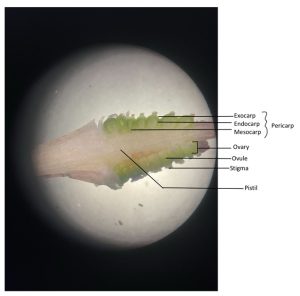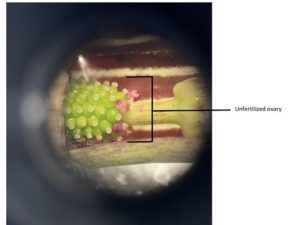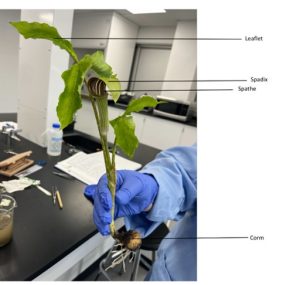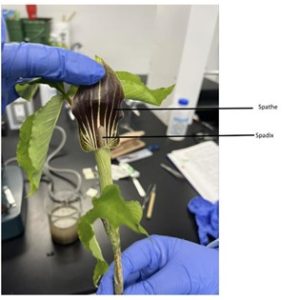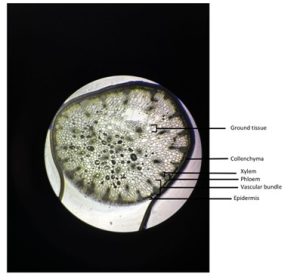1.9 Jack in the Pulpit
Colleen Mulvey
 Jack in the Pulpit (Arisaema triphyllum)
Jack in the Pulpit (Arisaema triphyllum)
Author: Colleen Mulvey
1. Plant Description
Jack in the Pulpit is of the vascular, flowering plant (angiosperm) phylum. It is from the monocot class, classified from the aroids, water-plantains, seagrass, and allies order. The genus it belongs to is the Jack-in-the-pulpit and Cobra lilies.
This plant is a perennial, meaning it reappears year after year after dying back to its corm in the winter. It is a herbaceous plant, meaning it does not have woody stems. It is not unique to the Carolinian zone, as it appears in mid-to-eastern states as well as Manitoba and the Maritimes, except Newfoundland and Labrador (Lady Bird Johnson Wildflower Center, n.d).
An adaptation that is notable is that the plant can change sex from year to year, depending on the previous year, how reproduction went and also its size and if the environmental conditions allow for it to change sexes (ridgetownrick, 2024). If the previous year was plentiful with nutrients, then it will become female, as females require a significantly greater amount of energy. This adaptation is called dichogamy and is a rare phenomenon in flowering plants (iNaturalist, n.d.).
2. Identification
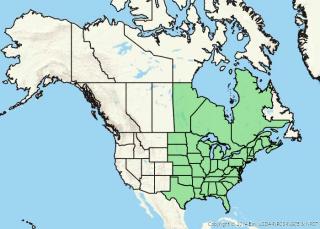
Jack in the Pulpit is native to mid-to-eastern Canada and eastern and midwestern United States. The leaves come with 2 leaves (alternate phyllotaxy) with 3 leaflets each that take on a T-shape formation on their own stems. There is a spathe (AKA the pulpit) that covers the spadix (AKA the Jack) underneath it (ridgetownrick, 2024). The spathe is lined with purple and white on the inside, and the outside has white and green lines. The spadix is completely covered by the spathe, and it has a purple and white pattern on it. The plant is distinct as it looks like the spathe is trying to hide and cover the spadix. The spathe completely encloses the spadix from the stem, and then it curls on top of it. The spadix can be seen coming out of the spathe tube. To identify whether the plant is Jack or Jill in the Pulpit, you would need to look inside the spathe leaves near the base of the spadix. If it is a Jill, it will have green, premature berries in spring and early summer, but bright red berries in mid to late summer. If it’s a Jack, stamens with pollen will be found at the base of the spadix (Nature Conservancy of Canada, n.d.). Some of its relatives include skunk cabbage (Symplocarpus foetidus) and arrow arum (Peltandra virginica).
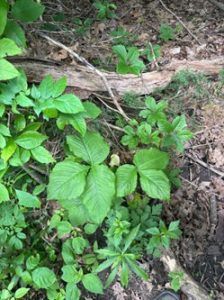
3. Cultivation
This plant requires a lot of patience to grow. To propagate, the seeds need a double dormancy, alternating cold and warm for 2-3 months for complete germination to occur. Upon planting the seeds 2cm deep, it may take two years or more to germinate in the soil. Then, the seedlings need to grow in soil for three or more years before they are mature enough to flower. This plant may also be propagated by root division (ridgetownrick, 2024). Jack in the Pulpit grows best in partial sunlight in the spring, then almost complete shade in the summer. They require moist soil and do not grow well in clay, and require a lot of organic matter in the soil to ensure a stable environment for growth (Gardenia, n.d.; Lady Bird Johnson Wildflower Center, n.d).
4. Indigenous Knowledge
Native Americans gathered the corms to eat as a vegetable, once dried or cooked. It is said that the root tastes like chocolate and was once ground up in bread dough. Some Indigenous peoples added the chopped-up corm to meat and left it for their enemies because it was toxic if uncooked. During the 1800s, parts of the dried plant were used to help treat asthma, rheumatism, bronchitis and whooping cough (Donabella, 2015; Foster, n.d.).
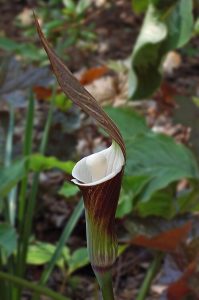
5. Life Cycle
- Development: This plant requires many years after germination to flower. When starting from seed, it can take 2–3 months for complete germination to occur. Once planted, it may take two or more years in soil before sprouting, and three or more years before it flowers—meaning over 5 years from seed to bloom (Munteanu, 2024; Foster, n.d.).
- Embryology: Once fertilized, the egg does not divide until endosperm development begins. Subspecies differ: A. triphyllum ssp. Triphyllum is tetraploid (56 chromosomes, most common); ssp. stewardsonii is diploid (28 chromosomes, bog/swamp specialist); ssp. Pusillum is diploid (28 chromosomes, southern). Hybrids sometimes occur; some genetic accidents double chromosome counts and restore fertility (The Primrose Path, n.d.). Embryo development matches other angiosperms, with initial free nuclear division before cell wall formation (Gow, 1908).
- Germination: Requires double dormancy, cold and warm cycles for 2–3 months, with germination only after two years or more underground (ridgetownrick, 2024).
- Seed development: Fertilized ovaries produce green berries that ripen red by late summer. Each berry contains 1–3 seeds, sometimes more (Gardenia, n.d.).
- Leaf arrangement: Two compound leaves, each with three T-shaped leaflets (alternate phyllotaxy). Females typically have two sets; non-flowering males often have one (Chayka, n.d.).
- Reproduction: Species can be dioecious (separate sexes) or monoecious (bisexual). Pollination is by fungus gnats, which carry pollen from male stamens at the base of spadix to female ovaries (Hilty, n.d; NC State Extension, n.d.)
- Evolution: Asian and North American Arisaema diverged after continental drift in the Mesozoic era. Climate differences drove diversification, now seen in spadix structures (Gracie, 2013)
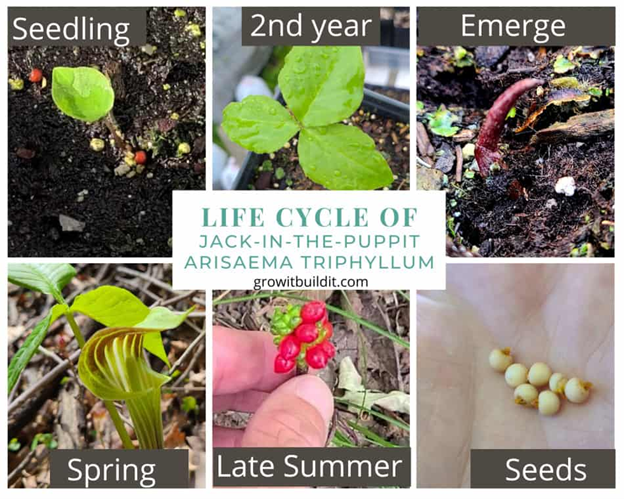
6. Anatomy and Physiology
- Tissues: The Arisaema family is more advanced than Spathicarpa, Aglaonema and Nephthytis, but less evolved than Dieffenbachia, Anthurium, Spathyema, Orontium and Arcorus. All share similar tissues/embryology, but Arisaema ovaries contain four ovules versus single basal ovaries in others (Gow, 1908).
- Transport: Vascular tissue forms continuous loops around leaf margins (Chayka, n.d.). Female plants show higher respiration/photosynthesis rates due to embryo/ovary demands and possess larger leaves for greater carbon assimilation (Vitt, 2001, 2020).
- Defenses: Produces oxalic acid, poisonous when ingested, causing mouth/throat burning (iNaturalist, n.d.). This deters deer and small animals (NC State Extension, n.d.).
7. Summary
The Jack-in-the-Pulpit is an extremely interesting plant, and it is amazing that it is native to our backyards. It is the hope that the next time you see this wonderful plant, you know how intricate and complex it is.
References
Chayka, K. (n.d.). Arisaema triphyllum (jack-in-the-pulpit). Minnesota Wildflowers. https://www.minnesotawildflowers.info/flower/jack-in-the-pulpit
Donabella, D. (2015, April 22). Simply the best natives—Jack-in-the-pulpit. Gardens Eye View. https://gardenseyeview.com/2015/04/22/simply-the-best-natives-jack-in-the-pulpit/
Foster, J. (n.d.). Jack-in-the-pulpit, a complete guide. GrowIt BuildIT. Retrieved October 9, 2025, from https://growitbuildit.com/arisaema-triphyllum-jack-in-the-pulpit/
Gardenia. (n.d.). Arisaema triphyllum (jack-in-the-pulpit). https://www.gardenia.net/plant/arisaema-triphyllum
Gow, J. E. (1908). Embryogeny of Arisaema triphyllum. Botanical Gazette, 45(1), 38–44. https://doi.org/10.1086/329443
Gracie, C. (2013, June 12). Jack-in-the-pulpit: Pollination by deception. New York Botanical Garden. https://www.nybg.org/blogs/plant-talk/2013/06/science/jack-in-the-pulpit-pollination-by-deception/
Hilty, J. (n.d.). Jack-in-the-pulpit (Arisaema triphyllum). Illinois Wildflowers. https://www.illinoiswildflowers.info/woodland/plants/jackpulpit.htm
iNaturalist. (n.d.). Jack-in-the-pulpit. Retrieved October 9, 2025, from https://www.inaturalist.org/taxa/50310-Arisaema-triphyllum
Lady Bird Johnson Wildflower Center. (n.d.). Arisaema triphyllum (jack-in-the-pulpit). https://www.wildflower.org/plants/result.php?id_plant=artr
Munteanu, N. (2024, May 26). The bizarre beauty of jack in the pulpit. The Meaning of Water. https://themeaningofwater.com/2024/05/26/the-bizarre-beauty-of-jack-in-the-pulpit/
Nature Conservancy of Canada. (n.d.). Jack-in-the-pulpit. https://www.natureconservancy.ca/en/what-we-do/resource-centre/featured-species/plants/jack-in-the-pulpit.html
NC State Extension. (n.d.). Arisaema triphyllum (bog onion; jack-in-the-pulpit; dragon root…). Extension Gardener Plant Toolbox. https://plants.ces.ncsu.edu/plants/arisaema-triphyllum/
ridgetownrick. (2024, November 24). Jack-in-the-pulpit. The Native Plant Gardener. https://nativeplantgardener.ca/jack-in-the-pulpit
The Primrose Path. (n.d.). The Arisaema triphyllum complex. https://www.theprimrosepath.com/Featured_Plants/Arisaema_triphyllum/triphyllumcomplex.htm
Vitt, P. (2001). Gender-related differences in gas exchange rates in the gender-switching species Arisaema triphyllum (Araceae). Rhodora, 103(916), 387–404. https://www.jstor.org/stable/23313419
Vitt, P. (2020, May 22). Jack-in-the-pulpit? Or Jill? Lake County Nature. https://lakecountynature.com/2020/05/22/jack-in-the-pulpit-or-jill/

